Oh what fun it is to see students engaged and learning, and with these activities on homophones, you will see both! Start with pretesting, move on to teaching and “gaming,” and end with students editing their writings.
Activities on Homophones to Pre-Assess
Commonly confused words such as homophones are on English teachers’ to-teach lists. However, while some students are confusing there, their, and they’re, others aren’t. For these reasons, it’s best to determine which students are making mistakes with which homophones. This allows teachers to individualize instruction, and a pretest offers a great place to begin.
Pretest with a Worksheet on Homophones
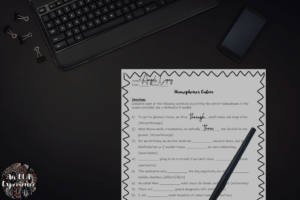
Start here. The simplest way to find out which homophones your students need practice with is to pretest with a fill-in-the-blank worksheet that quizzes them on a large number of homophones (around 25, not too many). When grading, note the question numbers that most students missed. These are the homophones that they’ll need direct instruction for. (Don’t return these papers to students until you start teaching homophones because they’ll also be used to differentiate.)
To create these, type sentences with homophones that you’ve noticed students having difficulties with. Include lines for their answers and give them homophones to choose from. If you’re pressed for time, then visit my TPT store for some ready-to-go resources, including “Homophones Galore,” a worksheet that works perfectly for a pretest.
Teach the Mistakes You Observe in Student Writing
This method is more time-consuming, but it’s truly effective. If students aren’t spelling their homophones correctly in their essays, then these are words they need to watch out for when they’re editing.
When I’m grading, I circle up to five misspelled words in their writings, and I keep a tally of words I see many students misspell. If you do this, you will see some common mistakes with homophones, ones you’ll want to cover.
I also have students keep their returned papers in manila folders, which we store in the classroom. They can refer to these when they’re working on their homophone booklets (discussed in the next section).
Activities on Homophones for Teaching
Homophone Anchor Chart
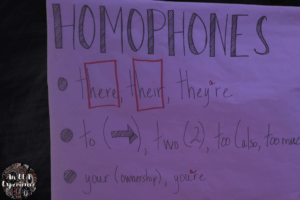
If you teach middle school ELA, then you will need an anchor chart for homophones because these are still a common problem at this age.
Start by titling a sheet of butcher paper homophones and hanging it on your wall. (It doesn’t need to be beautiful.)
Next, teach a minilesson on the problematic homophones seen in student writing and/or the pretest. Include definitions for the words and hints to help them remember them. For example, you might draw an arrow for the word to, write the number 2 for two, and write too in oversized letters. As you teach each minilesson, add these words and hints to your anchor chart. (For more details on anchor charts, visit “Blog # 9: Teaching Students to Edit a Little Every Day.”)
Homophone Magical Flip Booklet
This is where the differentiation comes in. Students create homophone booklets for the words they find challenging.
Begin by making the booklet. Give each student two sheets of light-colored paper (different colors) and demonstrate how to fold and label them.
- Begin by folding both sheets of paper in half hamburger style (with the short ends meeting).
- Now fold them in half again hotdog style (with the long ends meeting).
- Next, unfold one sheet so that it’s back to the hamburger-style position.
- Cut four slits from the folded side up to the crease (for ten words). Space them apart as evenly as possible.
- Take the other sheet and cut on the creases so that you end up with four strips of paper. (Each student will need two of these strips, so save the others for scratch paper or have students share these pages).
- Take the strips and weave them through the slits on the first page, over and under for one and under and over for the other.
- End by holding the edges of the paper, push the page inward, insert your thumbs into the middle, and watch the magic happen.
Next, return students’ pretests and/or folders to them, and have them note the homophones (or other commonly misspelled words) they’ve misspelled in the boxes (one word per box) along with a symbol or an image for each word. On the flip side, have them write a sentence with each word.
If you have perfect spellers, those few who didn’t miss any of the questions or have only a couple of words circled on their essays, give them a word list of homophones and have them choose the ones they’re unsure of. This gives them the individualized practice with homophones they need.
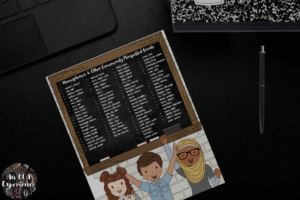
Fun Activities on Homophones
In Getting It Right: Fresh Approaches to Teaching Grammar, Usage, and Correctness, Michael W. Smith and Jeffrey D. Wilhelm state, “The more gamelike and social the atmosphere, the more risks students will take and the more they will engage.” And I do agree with them. Playing games with my students is always an educational treat (for them and me).
Homophone Jeopardy
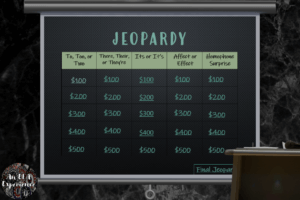
Teacher Prep
You can find Jeopardy templates for free on TPT. You write the categories and questions; a TPT seller has done everything else. Write easier questions for the $100.00 categories and more difficult ones for the $500.00 ones. For example, in the one I made, I included a there, their, and they’re category. The $100.00 question says, “This homophone is a contraction for they are.” The $500.00 question says, “This form of the homophone shows possession.”
Before the Game
Begin by assigning students (and/or yourself) the following jobs:
- A host to read the questions to the audience,
- a game operator to run the Jeopardy slideshow,
- a scorekeeper to tally points on the board, and
- a timekeeper to make sure questions are answered within the allotted time (e.g., ten to thirty seconds).
- Divide the remaining students into four or five teams, and do a quick game of rock, paper, scissors to decide which team will go first. That team will choose a category and a dollar amount.
During the Game
- The host reads the questions and the teams hit the buzzer when they are ready to answer. (If you don’t have a buzzer, have students raise their hands or move to a specific location when they’re ready to answer.)
- Team members must spell the word correctly to earn points. If the team answers the question correctly, then they are awarded the specified dollar amount. If they answer incorrectly, then that amount is deducted from their total.
- Continue playing the game until all dollar amounts have been awarded; then move on to Final Jeopardy. The team with the highest score wins.
Variations
- When a team answers a question correctly, they can choose the next category (as in the traditional Jeopardy game), or you can have the teams take turns.
- Decide whether you want students to answer in the form of a question.
- Have one team member answer for the team or have team members rotate.
Suggestions
- Allow teams to collaborate.
- Award the winning team a piece of candy (if your school allows this) or a dollar store toy.
- For some team building, ask students to decide on team names. If you’re in a hurry, assign them a name or a number.
I Have Who Has
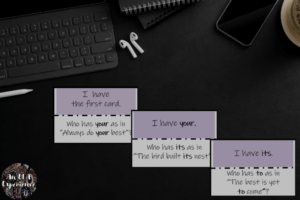
Teacher Prep
- Start by making a class set of cards (enough for your largest class). The first card should start with “I have the first card. Who has _____ as in _____?”
- The middle cards should say something like this: “I have _____. Who has _____ as in _____?”
- The last one should say, “I have ____. Game over.”
Game Directions
- Give each student one or two cards. Make sure to use every card so the game works properly.
- The game will begin with the student who has the card that says, for example, “I have the first card. Who has your as in always do your best?”
- The student who has that homophone will read his/her card next: “I have your. Who has its as in the bird build its nest?”
- Continue playing until all cards have been read.
- Congratulate students on a job well done.
Suggestions
- Use cardstock for printing the cards and/or laminate so you can use these again.
- As you play, toss a piece of candy to students as they correctly answer the questions (if your school allows you to do this).
- Differentiate by giving more challenging words (e.g., its or it’s) to your expert spellers and easier ones (e.g., two or they’re) to those who have difficulties with spelling.
Homophone Task Cards

Teacher Prep
You can create task cards much like you would a worksheet. Write questions that ask students to fill in the blank, answer multiple-choice questions, and write sentences with specific words. (I like to divide an 11 x 8 ½ inch PowerPoint or Google Slide into four sections with one question in each section.) Number each card one to ten, for example, and have students number sheets of paper from one to ten to use as an answer sheet.
Working Collaboratively or Individually
Tape the cards around your classroom (in either numerical order or hidden around the room for a scavenger hunt), making each card a station. Then play some music and have the students work collaboratively as they rotate through the stations. Because the students are moving around and engaged, this activity also provides time to conference with the students at the stations or to make yourself a station for individual or small-group learning.
Working Individually
The task cards can also be used with Scoot. Tape them to students’ desks and have students move to the next card whenever you say “Scoot.”
Homophone Bingo
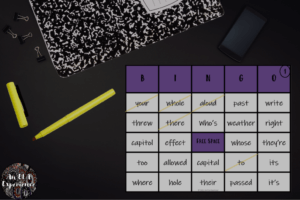
Teacher Prep
Begin by writing your questions on two 3×5 tables (in PowerPoint or Google Slides) so you’ll have fifteen words per page and thirty slips of paper (or bingo balls). I make my questions fill in the blank: Tokyo is the (capital or capitol) of Japan. Also, because I want to show the answers to the students for immediate feedback, I set up my page so that the answers will print on the back.
Next, create the bingo cards. You can find free bingo templates at both TPT and Canva, or you can create a 6×5 table and type BINGO in the top row. Make one copy for each student.
During class, ask students to write one homophone (from your bingo-ball list) into each square in random order. As soon as they’re finished, you’re ready to go.
Game Directions
- Draw a clue from a bowl/basket, and read and project the clue onto a screen for the students.
- Students who have that homophone mark it on their cards. (My students mark their cards with colored pencils and/or highlighters, using a different color for each game. Avoid using beans to mark cards because they will end up decorating your floor.)
- When students have five boxes connected in a row horizontally, vertically, or diagonally, they yell, “Bingo.”
- Check their cards to make sure they marked the correct homophones, and give them a small prize (e.g., candy, dollar store toy).
- Play another round. (Students can also win by marking four corners or the entire card.
Homophone Headband

Teacher Prep
Google homophone list, and select the homophones you’d like to use. Write these homophones on index cards (with one homophone on each card). Make enough for each small group of students (four to six per group) to have twenty cards.
Directions
Each group of students should have two to three teams. Place the homophone deck face down in the middle of the group. One team member draws a card without looking at it and holds it up to his/her forehead so team members can read it. Team members give the cardholder clues to the word, and the cardholder has one minute to say and spell the word correctly. Teams repeat this process until the cards are gone, and the team with the most points wins.
Activities on Homophones for Checking Student Drafts
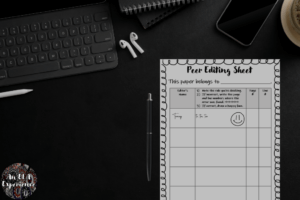
Of course, students must apply what they’ve been learning to their writing, so make time for students to check their drafts.
After you’ve covered even one set of homophones, students can start editing drafts of any writing (short or long) to check for those homophones. If they don’t have a particular homophone in their draft, have them add a sentence that uses it.
When self-editing, students can check the homophones included in their homophone booklets.
For peer editing, use a clocking activity or stations.
Related Links
Homophones for Practice–Game and Worksheet Bundle
14 Quick Tips for Teaching Homophones
Activities on Homophones in a Nutshell
- Pre-assess students to determine which homophones they need practice with.
- Teach mini lessons on those homophones and add them to a homophone anchor chart.
- Differentiate homophone instruction with a magical flip booklet.
- Give students practice with homophones with fun activities.
- Have students self and peer edit to apply their homophone knowledge to writing.
Leave a comment to let me know which activities on homophones your students had the most fun with!


